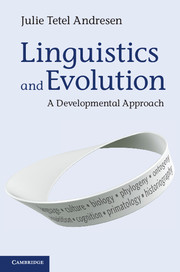Book contents
- Frontmatter
- Contents
- List of Figures
- Introduction Historiography’s contribution to theoretical linguistics
- Part I Theoretical considerations
- Part II A developmental systems linguistics
- 4 Evolutionary scenarios I: the standard story and the self-reproductionist script
- 5 Evolutionary scenarios II: the emerging story and the self-realizationist script
- 6 The ontogenic script begins
- 7 The ontogenic script continues
- Part III What to do next
- Bibliography
- Name index
- Subject index
7 - The ontogenic script continues
Published online by Cambridge University Press: 05 June 2014
- Frontmatter
- Contents
- List of Figures
- Introduction Historiography’s contribution to theoretical linguistics
- Part I Theoretical considerations
- Part II A developmental systems linguistics
- 4 Evolutionary scenarios I: the standard story and the self-reproductionist script
- 5 Evolutionary scenarios II: the emerging story and the self-realizationist script
- 6 The ontogenic script begins
- 7 The ontogenic script continues
- Part III What to do next
- Bibliography
- Name index
- Subject index
Summary
The question posed at the end of the previous chapter remains: what influence – if any – does a particular language have on the being, doing and knowing of any given languaging living being or group of languaging living beings? The answer will take us into the intriguing realm of linguistic relativity, where we will need to provide a developmental-systems-theory-inspired account of how particular languages may affect particular languagers in the dimensions of number, color, time and space. As usual, such an account will require “a more generally phrased discussion,” as Waddington recommended for evolutionary studies in Chapter 2.
Virtuous circles
In their lovely turn of phrase, Maturana and Varela speak of the “unbroken coincidence of our being, our doing, and our knowing” (1992: 24). The poetry of the unbroken coincidence invites a bit of explanatory prose. Maturana and Varela favor circles. For them, going in circles is not a vice but a virtue. What we do is bound to our experience of the world. What we know does not differ from who we are. Who we are determines what we do. We are dynamic feedback systems of being, of doing, and of knowing. If you finish Linguistics and Evolution with one idea, let it be this: our being, our doing, and our knowing are inseparable. If you want a second take-home idea, it is this: we are our being, we do our doing, and we know our knowing through our languaging together – as this very sentence, paragraph, chapter and book attest.
- Type
- Chapter
- Information
- Linguistics and EvolutionA Developmental Approach, pp. 196 - 226Publisher: Cambridge University PressPrint publication year: 2013

